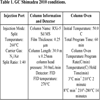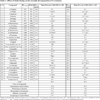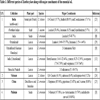- Home
- About Journals
-
Information for Authors/ReviewersEditorial Policies
Publication Fee
Publication Cycle - Process Flowchart
Online Manuscript Submission and Tracking System
Publishing Ethics and Rectitude
Authorship
Author Benefits
Reviewer Guidelines
Guest Editor Guidelines
Peer Review Workflow
Quick Track Option
Copyediting Services
Bentham Open Membership
Bentham Open Advisory Board
Archiving Policies
Fabricating and Stating False Information
Post Publication Discussions and Corrections
Editorial Management
Advertise With Us
Funding Agencies
Rate List
Kudos
General FAQs
Special Fee Waivers and Discounts
- Contact
- Help
- About Us
- Search

The Open Bioactive Compounds Journal
(Discontinued)
ISSN: 1874-8473 ― Volume 9, 2020
Drying Potential of Leaves Oil of Zanthoxylum armatum DC from North India
Lata Rana1, Ankita Rai2, Lalit M. Tewari2, Neha Chopra2, Naveen C. Pandey2, Geeta Tewari1, *
Abstract
Background:
The study on drying and its social acceptance has increased rapidly. Among different drying techniques, shade drying is one of the most feasible methods to keep intact from the decay of the main active components of the plant materials. Shade drying is an ancient drying method that increases durability, major constituents and activity of the plant material.
Aims:
Research was conducted to examine the drying potential of aromatic leaves oil of Zanthoxylum armatum DC.
Methods:
The fresh plant material was collected from Lohaghat, Champawat district of Uttarakhand and hydrodistilled before and after shade drying to assess the changes in the quality of volatile constituents by GC and GC-MS techniques. A two-tailed paired t-test was executed to assess the difference between drying treatments using MS-Excel.
Results:
The major components in the fresh oil were 2-undecane, linalool, (E)-β-ocimene, α-pinene and β-phellandrene. In the oil from dried material, the three predominant compounds were noted. A significant increase was observed in the percentage of β-phellandrene, undecanal and myrcene after shade drying (p<0.01). Five components absent in the fresh plant material appeared and one disappeared during the drying process.
Conclusion:
Shade drying significantly influenced the essential oil composition of Z. armatum.
Article Information
Identifiers and Pagination:
Year: 2021Volume: 9
Issue: Suppl-1, M3
First Page: 9
Last Page: 14
Publisher Id: TOBCJ-9-9
DOI: 10.2174/1874847302109010009
Article History:
Received Date: 20/03/2020Revision Received Date: 12/05/2020
Acceptance Date: 19/05/2020
Electronic publication date: 18/06/2021
Collection year: 2021
open-access license: This is an open access article distributed under the terms of the Creative Commons Attribution 4.0 International Public License (CC-BY 4.0), a copy of which is available at: (https://creativecommons.org/licenses/by/4.0/legalcode). This license permits unrestricted use, distribution, and reproduction in any medium, provided the original author and source are credited.
* Address correspondence to this author at the Department of Chemistry, D. S. B. Campus, Kumaun University, Nainital, India; Tel: 09412438823; E-mail: geeta_k@rediffmail.com
| Open Peer Review Details | |||
|---|---|---|---|
| Manuscript submitted on 20-03-2020 |
Original Manuscript | Drying Potential of Leaves Oil of Zanthoxylum armatum DC from North India | |
1. INTRODUCTION
The drying technique has been playing a successful role in the storage and food safety since ancient times. Efforts on drying methodology should be made to raise the active components of the aromatic herbs. These active components are the major part of various drugs, spices, natural beauty products, aroma profiles and are responsible for anticancer, antiaging, anti-oxidant, anti-microbial, anti-inflammatory and other various activities [1Bisht M, Rana L, Tewari G, Pande C, Bhatt S. Effect of natural drying methods on flavour profile of camphor rich Ocimum americanum L. from North India. Asian J Chem 2019; 31(6): 1321-6.
[http://dx.doi.org/10.14233/ajchem.2019.21862] ]. Shades drying, sun-drying, air-drying, oven-drying, microwave-drying, fluidized-drying and freeze-drying are the most useful methods which influence drying technology. Shade drying represents the most traditional and more commonly used method to preserve the colour, quality and activity response of the major compounds of essential oils as compared to other drying methods. Dried herbs have been good sources of essential micronutrients, the main ingredient of the dishes and a small amount is responsible for colour, sweet aroma and tangy flavors [2Bhatt S, Tewari G, Pande C, Bisht M, Prakash O, Rana L. Evaluation of antioxidant potential and quality of volatile constituents of fresh and sun dried Ocimum gratissimum. J Indian Chem Soc 2019; 96: 297-304.]. Dried herbs become more valuable worldwide with beneficial health impacts. Therefore, different drying methods need to be part of the research.
Zanthoxylum armatum DC, is one of the most famous winged prickly aromatic shrubs belonging to the family Rutaceae, which comprises about 150 genera distributed worldwide [3Waheed A, Mahmud S, Akhtar M, Nazir T. Studies on the components of essential oil of Zanthoxylum armatum by GC-MS. Am J Anal Chem 2011; 2: 258-61.
[http://dx.doi.org/10.4236/ajac.2011.22031] ]. It is native of India, China, Korea and Japan, mostly grow in wastelands, mountains, valleys, forests at an altitude range of approximately 1000-2500m. This wild aromatic spiny shrub is often locally known as Tejphal, Timur, Tejowati, Nepal pepper and Toothache tree [4Barua CC, Yasmin N, Elancheran R. A review on effective utilization, phytochemical compounds, pharmacological intervention of a popularly used plant for developing a new drug: Zanthoxylum armatum with reference to its anticancer activity. MOJ Bioequiv Availab 2018; 5(3): 156-67.
[http://dx.doi.org/10.15406/mojbb.2018.05.00097] ]. Zanthoxylum armatum leaves, fruits, bark, seeds and young sticks are well known for their therapeutic potential as a medicinal component and widely used for carminative, stomachache, rheumatism, toothache, antipyretic, sudorific and anthelmintic properties [5Bhatt V, Sharma S, Kumar N, Sharma U, Singh B. Chemical Composition of Essential Oil among Seven Populations of Zanthoxylum armatum from Himachal Pradesh: Chemotypic and seasonal variation. Nat Prod Commun 2017; 12(10): 1643-6.
[http://dx.doi.org/10.1177/1934578X1701201030] ]. Earlier studies show that the complete plant parts, i.e., bark, seeds, leaves, root and fruits, are a great source of alkaloids, steroids, flavonoids, amides, lignans, terpenes, carbohydrates, proteins and essential oils [6Singh TP, Singh OM. Phytochemical and pharmacological profile of Zanthoxylum armatum DC.- An overview. Indian J Nat Prod Resour 2011; 2: 275-85.http://hdl.handle.net/123456789/12730]. The fruits and young sticks of Z. armatum are the main components of traditionally used herbal toothpaste and to keep gum strengthen and hygienic. The barks, as well as fruits, are also useful in various types of skin disease, wounds, eye and ear disease, cough, fever, etc. Dried ground leaves and seeds of Zanthoxylum species are used in spice, soup and flavor products [4Barua CC, Yasmin N, Elancheran R. A review on effective utilization, phytochemical compounds, pharmacological intervention of a popularly used plant for developing a new drug: Zanthoxylum armatum with reference to its anticancer activity. MOJ Bioequiv Availab 2018; 5(3): 156-67.
[http://dx.doi.org/10.15406/mojbb.2018.05.00097] , 7Dai DN, Luong NX, Thang TD, Jirovetz L, Höferl M, Schmidt E. Chemical composition of the essential oil of Zanthoxylum avicennae (Lam.) DC leaves (Rutaceae) from Vietnam. J Essent Oil Bear Pl 2012; 15(1): 7-11.
[http://dx.doi.org/10.1080/0972060X.2012.10644012] ]. The chemical composition of the essential oil of the same species might be different due to different environmental, seasonal, geographical distribution (i.e., different longitude and latitude), different physicochemical properties of soils, different time of harvesting and different plant parts at different stages.
There are several reports on antimalarial [8Tiwari M, Naik SN, Mittal PK, Yadav S. Chemical composition of Zanthoxylum armatum DC against three mosquito vector. J Vector Borne Dis 2007; 44(3): 198-204.
[PMID: 17896622] , 9Bisht D, Chanotiya CS. 2-undecanone rich leaf essential oil from Zanthoxylum armatum. Nat Prod Commun 2011; 6(1): 111-4.
[http://dx.doi.org/10.1177/1934578X1100600126] [PMID: 21366058] ], essential oil composition and anti-inflammatory [10Sati SC, Sati MD, Raturi R, Badoni P, Singh H. Anti-inflammatory and antioxidant activities of Zanthoxylum armatum stem bark. Eng Global J Res Eng 2011; 11(5): 19-21.], anthelmintic [11Mehta DK, Das R, Bhandari A. In-vitro anthelmintic activity of seed of Zanthoxylum alatum DC. against Pheretima posthuma 2012; 6(1): 26-8.], antifungal, antibacterial, antimicrobial [12Manandhar A, Tiwari RD. Antifungal efficacy of Zanthoxylum oil against Bipolaris sorokiniana (Sacc.) Shoem. Ecoprint. Int J Ecol 2005; 12: 91-3.
[http://dx.doi.org/10.3126/eco.v12i0.3206] -14Srivastava N, Kainthola A, Bhatt AB. vitro antimicrobial activity of bark extract of an ethnic plant Zanthoxylum alatum DC against selected human pathogens in Uttarakhand Himalaya Int J Herb Med 2013; 1(3): 21-4.], anticancer [15Verma N, Khosa RL. Hepatoprotective activity of leaves of Zanthoxylum armatum DC in CCl4 induced hepatotoxicity in rats. Indian J Biochem Biophys 2010; 47(2): 124-7.http://hdl.handle.
net/123456789/8265
[PMID: 20521628] , 16Singh TD, Meitei HT, Sharma AL, Robinson A, Singh LS, Singh TR. Anticancer properties and enhancement of therapeutic potential of cisplatin by leaf extract of Zanthoxylum armatum DC. Biol Res 2015; 48(1): 46.
[http://dx.doi.org/10.1186/s40659-015-0037-4] [PMID: 26290043] ] and antioxidant free radical scavenging [17Batool F, Sabir SM, Rocha JBT, Shah AH, Saify ZS, Ahmed SD. Evaluation of antioxidant and free radical scavenging activities of fruit extract from Zanthoxylum alatum: a commonly used spice from Pakistan. Pak J Bot 2010; 42(6): 4299-311.] activities of extract and essential oil of Z. armatum. Variation in the essential oil composition of different drying methods on some aromatic plants of family Rutaceae has been reported on Murraya koenigii L [18Kenghe RN, Jadhav MS, Nimbalkar CA, Kamble TM. Effect of drying methods on quality characteristics of curry (Murraya koenigii) leaves. Int J Environ Agric Res 2015; 1(5): 8-12., 19Rani A, Bisht M, Pande C, Tewari G, Bhatt S, Matiyani M. Effect of drying on the volatiles of leaves of Murraya koenigii (L.). Spreng J Essent Oil Bear Pl 2017; 20(2): 52-558.
[http://dx.doi.org/10.1080/0972060X.2017.1317606] ]. from north India, Citrus reticulata (Kinnow), C. sinensis (Mussami) and C. paradisii (Grapefruit) from Pakistan [20Kamal GM, Anwar F, Hussain AI, Sarri N, Ashraf MY. Yield and chemical composition of Citrus essential oils as affected by drying pretreatment of peels. Int Food Res J 2011; 18(4): 1275-82.]. To the best of our knowledge, no earlier reports on the drying effect of the leaves oil of Z. armatum have been found. Therefore, this study was undertaken to investigate the effect of drying on Z. armatum leaves essential oil. For the effective production of essential oil, knowledge of the suitable post-harvest technique is needed for high-quality products. This study reflects on the potential of a shade drying approach on Z. armatum.
2. MATERIALS AND METHODS
2.1. Collection and Identification of Z. armatum
Fresh leaves of Zanthoxylum armatum were collected from the wild field of Lohaghat (Latitude 29.404178; Longitude 80.0943366; Altitude 5869 ft), Champawat district, Uttarakhand in the month of September 2018. A fraction of plant material was shade dried (20±5°C) until a constant weight was obtained. The identification of the plant was done at Botany Department, D. S. B. Campus, Nainital (Acc. No. AR01).
2.2. Extraction of Essential Oil
Fresh and shade dried plant materials were sliced into small parts and 500 g and 200 g of fresh (ZFL) and dried (ZDL) samples were extracted by using the hydrodistillation method in a Clevenger apparatus for 5 hours [18Kenghe RN, Jadhav MS, Nimbalkar CA, Kamble TM. Effect of drying methods on quality characteristics of curry (Murraya koenigii) leaves. Int J Environ Agric Res 2015; 1(5): 8-12.] and 2.5 mL and 0.6 mL oils were obtained, respectively. The oils were dried over anhydrous sodium sulphate and stored in glass vials in Biological Oxygen Demand (BOD) incubator prior to the analysis [19Rani A, Bisht M, Pande C, Tewari G, Bhatt S, Matiyani M. Effect of drying on the volatiles of leaves of Murraya koenigii (L.). Spreng J Essent Oil Bear Pl 2017; 20(2): 52-558.
[http://dx.doi.org/10.1080/0972060X.2017.1317606] ]. All the experiments were performed in three replicates.
2.3. Analysis of Extracted Oil
GC conditions are summarized in Table 1.
The GC/MS used was 2010 GC coupled with Shimadzu QP 2010 plus with thermal desorption system TD 20 having Rtx-5 capillary column (30m x 0.25mm with film thickness 0.25µm). The GC-MS was programmed in similar conditions to those of GC. Helium was used as a carrier gas and the injector temperature was 230°C. The injection volume was 0.2μL diluted oil in n-hexane with split mode (split ratio 1:40). MS was taken at 70eV with a mass range of 40-650amu [21Bhatt S, Tewari G, Pande C, Rana L. Impact of drying methods on essential oil composition of Ocimum americanum L. from Kumaun Himalayas. J Essent Oil Bear Pl 2018; 21(5): 1385-96.
[http://dx.doi.org/10.1080/0972060X.2018.1543031] ].
2.4. Identification of the Volatile Components
The identification of the oil components was done on the basis of their Retention Index (RI) which was calculated with respect to n-alkane series (C9-C33; Polyscience Corp., Niles IL) under similar GC conditions, MS Library (NIST:NIH version 2.1 and WILEY: 7th edition), comparison with the existing MS literature data [22Adams RP. Identification of Essential Oil Components by Gas Chromatography-Mass Spectrometry 2007.] and the relative amount of individual volatile component was calculated on the basis of GC peak area without using any response factor [21Bhatt S, Tewari G, Pande C, Rana L. Impact of drying methods on essential oil composition of Ocimum americanum L. from Kumaun Himalayas. J Essent Oil Bear Pl 2018; 21(5): 1385-96.
[http://dx.doi.org/10.1080/0972060X.2018.1543031] ].
2.5. Statistical Analysis
The mean and standard deviation of triplicate values were calculated using MS-Excel and the analyzed data was presented as mean ± standard deviation (SD). Two-tailed paired t-test was executed to compare mean values of percentage of constituents between fresh and shade dried Z. armatum at a probability level of p<0.01 and p<0.05 using MS-Excel [2Bhatt S, Tewari G, Pande C, Bisht M, Prakash O, Rana L. Evaluation of antioxidant potential and quality of volatile constituents of fresh and sun dried Ocimum gratissimum. J Indian Chem Soc 2019; 96: 297-304.].
3. RESULTS AND DISCUSSION
3.1. Essential Oil Yield of Z. armatum
The oil yield of fresh Z. armatum leaves (0.5%; v/w) was higher as compared to the shade dried (0.3%) plant material. The obtained essential oils were found to be pale yellow in colour. According to Weyerstahl et al. (1999), oil yield was acquired 0.5% from the fresh leaves of Z. alatum [23Weyerstahl P, Marschall H, Splittgerber U, Son PT, Giang PM, Kaul VK. Constituents of the essential oil from the fruits of Zanthoxylum rhetsoides drake from Vietnam and from the aerial parts of Zanthoxylum alatum Roxb. from India. Flavour Fragrance J 1999; 14: 225-9.
[http://dx.doi.org/10.1002/(SICI)1099-1026(199907/08)14:4<225::AID-FFJ818>3.0.CO;2-1] ]. Luong et al. (2003) from Vietnam reported 0.52% oil yield of dried Z. alatum leaves [24Luong NX, Hac LV, Dung NX. Chemical composition of the leaf oil of Zanthoxylum alatum Roxb. from Vietnam. J Essent Oil Bear Pl 2003; 6(3): 179-84.
[http://dx.doi.org/10.1080/0972-060X.2003.10643348] ]. In a report from China, among six air-dried plant materials (leaves and branches) of the genus Zanthoxylum, the highest oil yield (0.53%) was observed for Z. armatum DC [25Zhang W, Zhang Z, Chen Z, et al. Chemical composition of essential oils from six zanthoxylum species and their repellent activities against two stored-product insects. J Chem 2007; (7): 1287362
[http://dx.doi.org/10.1155/2017/1287362] ].
3.2. Essential Oil Composition of Fresh and Dried Leaves
GC (Figs. 1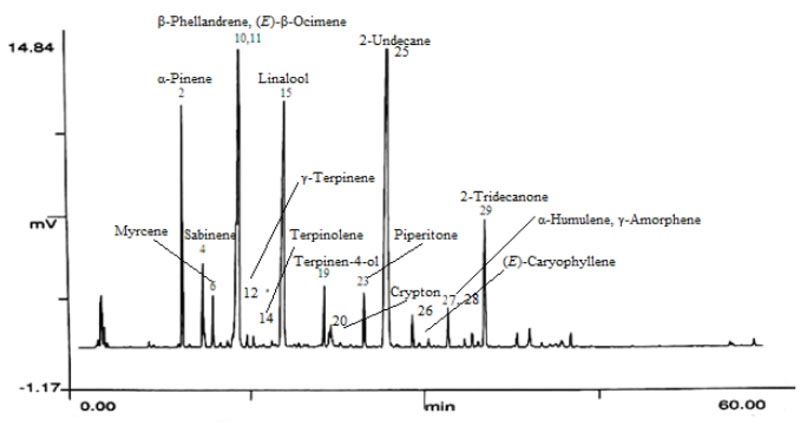 and 2
and 2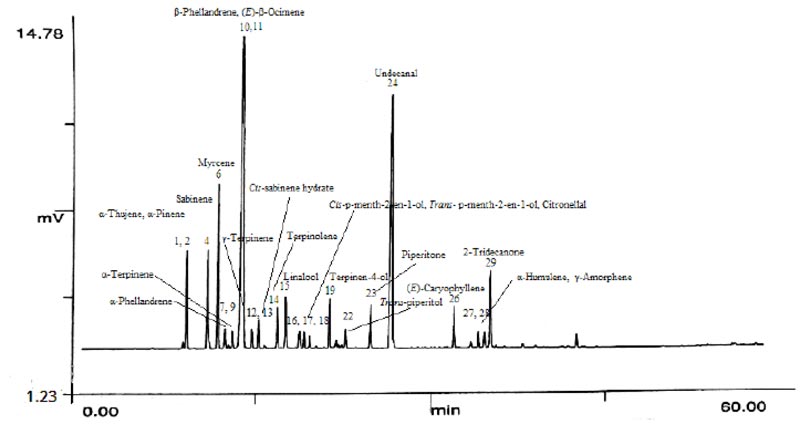 ) and GC/MS analysis revealed the presence of 42 and 51 out of which twenty-six and thirty compounds were identified representing 90.6% and 96.9% of the total oil in fresh and shade dried leaves of Z. armatum, respectively (Table 1). The major components in the fresh oil were 2-undecane (30.0%), linalool (15.9%), (E)-β-ocimene (14.9%), α-pinene (7.4%) and β-phellandrene (6.7%) (Table 2).
) and GC/MS analysis revealed the presence of 42 and 51 out of which twenty-six and thirty compounds were identified representing 90.6% and 96.9% of the total oil in fresh and shade dried leaves of Z. armatum, respectively (Table 1). The major components in the fresh oil were 2-undecane (30.0%), linalool (15.9%), (E)-β-ocimene (14.9%), α-pinene (7.4%) and β-phellandrene (6.7%) (Table 2).
 |
Fig. (1) Gas Chromatogram of ZFL essential oil. |
 |
Fig. (2) Gas Chromatogram of ZDL essential oil. |
An Indian report suggested that the essential oil of mature dried seeds of Z. armatum was found to be rich in linalool [26Jain N, Srivastava SK, Aggarwal LKK, Ramesh S, Kumar S. Essential oil composition of Zanthoxylum alatum seeds from northern India. Flavour Fragrance J 2001; 16: 408-10.
[http://dx.doi.org/10.1002/ffj.1024] ]. In contrast, Waheed et al. (2011) from Pakistan reported that linalool was totally absent in the seeds oil of Z. armatum. However, 3-borneol was the major constituent [3Waheed A, Mahmud S, Akhtar M, Nazir T. Studies on the components of essential oil of Zanthoxylum armatum by GC-MS. Am J Anal Chem 2011; 2: 258-61.
[http://dx.doi.org/10.4236/ajac.2011.22031] ]. Seeds contained the highest amount of linalool (71.0%) as compared to the other plant parts [26Jain N, Srivastava SK, Aggarwal LKK, Ramesh S, Kumar S. Essential oil composition of Zanthoxylum alatum seeds from northern India. Flavour Fragrance J 2001; 16: 408-10.
[http://dx.doi.org/10.1002/ffj.1024] ]. Reported data from Himachal Pradesh and Uttarakhand resemble with the presence of 2-undecanone as the major component in the leaf oil [5Bhatt V, Sharma S, Kumar N, Sharma U, Singh B. Chemical Composition of Essential Oil among Seven Populations of Zanthoxylum armatum from Himachal Pradesh: Chemotypic and seasonal variation. Nat Prod Commun 2017; 12(10): 1643-6.
[http://dx.doi.org/10.1177/1934578X1701201030] , 9Bisht D, Chanotiya CS. 2-undecanone rich leaf essential oil from Zanthoxylum armatum. Nat Prod Commun 2011; 6(1): 111-4.
[http://dx.doi.org/10.1177/1934578X1100600126] [PMID: 21366058] ]. On the other hand, Z. alatum from Vietnam has shown that 1,8-cineol (41.0%) was the major component [24Luong NX, Hac LV, Dung NX. Chemical composition of the leaf oil of Zanthoxylum alatum Roxb. from Vietnam. J Essent Oil Bear Pl 2003; 6(3): 179-84.
[http://dx.doi.org/10.1080/0972-060X.2003.10643348] ] (Table 3).
Different extraction techniques, plant origin, genetic traits and other environmental factors might be responsible for these differences in chemical composition. In the oil from dried material, the predominant compounds were β-phellandrene (35.5%), undecanal (22.5%) and myrcene (7.6%). Reported data from China revealed the presence of β-terpinene (45.56%), piperitone (33.47%), and 3-carene (8.88%) as the major components in dried Z. armatum [25Zhang W, Zhang Z, Chen Z, et al. Chemical composition of essential oils from six zanthoxylum species and their repellent activities against two stored-product insects. J Chem 2007; (7): 1287362
[http://dx.doi.org/10.1155/2017/1287362] ]. The mean percentage of α-pinene (7.4-3.6%), (E)-β-ocimene (14.9-1.7%), 2-undecane (30.0-0.0%) and linalool (15.9-2.7%) decreased significantly (p<0.01) while that of myrcene (1.4-7.6%), β-phellandrene (6.7-35.5%) and undecanal (0.0-22.5%) increased significantly (p<0.01) on shade drying of Z. armatum. Five compounds, namely, δ-3-carene, cis-sabinene hydrate, cis-p-menth-2-en-1-ol, undecanal and (E,E)-α-farnesene, which were absent in fresh plant material, appeared during the drying process. Only one component, i.e., camphene, disappeared in the oil of shade-dried plant material. The major composition of fresh Z. armatum leaves was aliphatic compounds (34.7%) followed by monoterpene hydrocarbons (33.8%) while monoterpene hydrocarbons (57.2%) and aliphatic compounds (27%) were the predominant compounds in the dried plant (Table 2).
The main components of dried plant material, particularly β-phellandrene and myrcene, are reported to show antimicrobial and antifungal activity [27Rajeshwari U, Andallu B. Medicinal benefits of coriander (Coriandrum sativum L). Spatula DD 2011; 1(1): 51-8.
[http://dx.doi.org/10.5455/spatula.20110106123153] , 28Bhatt S, Tewari G, Pande C, Prakash O, Tripathi S. Aroma profile and antioxidant potential of Origanum vulgare L.: Impact of drying. J Essent Oil Bear Pl 2019; 22(1): 214-30.
[http://dx.doi.org/10.1080/0972060X.2019.1599736] ]. During the drying process, the changes in the percentage of various volatile components are probably due to chemical reactions such as the breakdown of glycosylates, esterification, dehydration reactions, or oxidation reactions or may be the consequences of cell rupture [29Bartley JP, Jacobs AL. Effects of drying on flavor compounds in Australian-grown ginger (Zingiber officinale). J Sci Food Agric 2000; 30(20): 209-15.
[http://dx.doi.org/10.1002/(SICI)1097-0010(20000115)80:2<209::AID-JSFA516>3.0.CO;2-8] ].
CONCLUSION
In the present study, the essential oil composition of leaves of Z. armatum subjected to natural shade drying was compared with fresh oil using a two-tailed t-test. Finally, it can be concluded that shade drying showed a significant effect on essential oil yield and components. Shade drying decreased the oil content, percentage of α-pinene, (E)-β-ocimene and linalool. Therefore, efforts should be taken to illustrate the proper drying method for a particular plant species to increase the emerging market of drying.
ETHICAL STATEMENT
Fresh leaves of Zanthoxylum armatum were collected from the wild field of Lohaghat (Latitude 29.404178; Longitude 80.0943366; Altitude 5869 ft), Champawat district, Uttarakhand in the month of September 2018.
CONSENT FOR PUBLICATION
Not applicable.
AVAILABILITY OF DATA AND MATERIALS
Not applicable.
FUNDING
None.
CONFLICT OF INTEREST
The authors declare no conflict of interest, financial or otherwise.
ACKNOWLEDGEMENTS
The authors are grateful to IERP, Kosi, Katarmal for financial support and Head, Department of Botany, D. S. B. Campus, Kumaun University, Nainital for providing necessary lab facilities.
REFERENCES
| [1] | Bisht M, Rana L, Tewari G, Pande C, Bhatt S. Effect of natural drying methods on flavour profile of camphor rich Ocimum americanum L. from North India. Asian J Chem 2019; 31(6): 1321-6. [http://dx.doi.org/10.14233/ajchem.2019.21862] |
| [2] | Bhatt S, Tewari G, Pande C, Bisht M, Prakash O, Rana L. Evaluation of antioxidant potential and quality of volatile constituents of fresh and sun dried Ocimum gratissimum. J Indian Chem Soc 2019; 96: 297-304. |
| [3] | Waheed A, Mahmud S, Akhtar M, Nazir T. Studies on the components of essential oil of Zanthoxylum armatum by GC-MS. Am J Anal Chem 2011; 2: 258-61. [http://dx.doi.org/10.4236/ajac.2011.22031] |
| [4] | Barua CC, Yasmin N, Elancheran R. A review on effective utilization, phytochemical compounds, pharmacological intervention of a popularly used plant for developing a new drug: Zanthoxylum armatum with reference to its anticancer activity. MOJ Bioequiv Availab 2018; 5(3): 156-67. [http://dx.doi.org/10.15406/mojbb.2018.05.00097] |
| [5] | Bhatt V, Sharma S, Kumar N, Sharma U, Singh B. Chemical Composition of Essential Oil among Seven Populations of Zanthoxylum armatum from Himachal Pradesh: Chemotypic and seasonal variation. Nat Prod Commun 2017; 12(10): 1643-6. [http://dx.doi.org/10.1177/1934578X1701201030] |
| [6] | Singh TP, Singh OM. Phytochemical and pharmacological profile of Zanthoxylum armatum DC.- An overview. Indian J Nat Prod Resour 2011; 2: 275-85.http://hdl.handle.net/123456789/12730 |
| [7] | Dai DN, Luong NX, Thang TD, Jirovetz L, Höferl M, Schmidt E. Chemical composition of the essential oil of Zanthoxylum avicennae (Lam.) DC leaves (Rutaceae) from Vietnam. J Essent Oil Bear Pl 2012; 15(1): 7-11. [http://dx.doi.org/10.1080/0972060X.2012.10644012] |
| [8] | Tiwari M, Naik SN, Mittal PK, Yadav S. Chemical composition of Zanthoxylum armatum DC against three mosquito vector. J Vector Borne Dis 2007; 44(3): 198-204. [PMID: 17896622] |
| [9] | Bisht D, Chanotiya CS. 2-undecanone rich leaf essential oil from Zanthoxylum armatum. Nat Prod Commun 2011; 6(1): 111-4. [http://dx.doi.org/10.1177/1934578X1100600126] [PMID: 21366058] |
| [10] | Sati SC, Sati MD, Raturi R, Badoni P, Singh H. Anti-inflammatory and antioxidant activities of Zanthoxylum armatum stem bark. Eng Global J Res Eng 2011; 11(5): 19-21. |
| [11] | Mehta DK, Das R, Bhandari A. In-vitro anthelmintic activity of seed of Zanthoxylum alatum DC. against Pheretima posthuma 2012; 6(1): 26-8. |
| [12] | Manandhar A, Tiwari RD. Antifungal efficacy of Zanthoxylum oil against Bipolaris sorokiniana (Sacc.) Shoem. Ecoprint. Int J Ecol 2005; 12: 91-3. [http://dx.doi.org/10.3126/eco.v12i0.3206] |
| [13] | Negi JS, Bisht VK, Bhandari AK, Bisht R, Negi KS. Major constituents, antioxidant and antibacterial activities of Zanthoxylum armatum DC. Iranian J Pharma Therapeutics 2012; 11(2): 68-72. |
| [14] | Srivastava N, Kainthola A, Bhatt AB. vitro antimicrobial activity of bark extract of an ethnic plant Zanthoxylum alatum DC against selected human pathogens in Uttarakhand Himalaya Int J Herb Med 2013; 1(3): 21-4. |
| [15] | Verma N, Khosa RL. Hepatoprotective activity of leaves of Zanthoxylum armatum DC in CCl4 induced hepatotoxicity in rats. Indian J Biochem Biophys 2010; 47(2): 124-7.http://hdl.handle.
net/123456789/8265 [PMID: 20521628] |
| [16] | Singh TD, Meitei HT, Sharma AL, Robinson A, Singh LS, Singh TR. Anticancer properties and enhancement of therapeutic potential of cisplatin by leaf extract of Zanthoxylum armatum DC. Biol Res 2015; 48(1): 46. [http://dx.doi.org/10.1186/s40659-015-0037-4] [PMID: 26290043] |
| [17] | Batool F, Sabir SM, Rocha JBT, Shah AH, Saify ZS, Ahmed SD. Evaluation of antioxidant and free radical scavenging activities of fruit extract from Zanthoxylum alatum: a commonly used spice from Pakistan. Pak J Bot 2010; 42(6): 4299-311. |
| [18] | Kenghe RN, Jadhav MS, Nimbalkar CA, Kamble TM. Effect of drying methods on quality characteristics of curry (Murraya koenigii) leaves. Int J Environ Agric Res 2015; 1(5): 8-12. |
| [19] | Rani A, Bisht M, Pande C, Tewari G, Bhatt S, Matiyani M. Effect of drying on the volatiles of leaves of Murraya koenigii (L.). Spreng J Essent Oil Bear Pl 2017; 20(2): 52-558. [http://dx.doi.org/10.1080/0972060X.2017.1317606] |
| [20] | Kamal GM, Anwar F, Hussain AI, Sarri N, Ashraf MY. Yield and chemical composition of Citrus essential oils as affected by drying pretreatment of peels. Int Food Res J 2011; 18(4): 1275-82. |
| [21] | Bhatt S, Tewari G, Pande C, Rana L. Impact of drying methods on essential oil composition of Ocimum americanum L. from Kumaun Himalayas. J Essent Oil Bear Pl 2018; 21(5): 1385-96. [http://dx.doi.org/10.1080/0972060X.2018.1543031] |
| [22] | Adams RP. Identification of Essential Oil Components by Gas Chromatography-Mass Spectrometry 2007. |
| [23] | Weyerstahl P, Marschall H, Splittgerber U, Son PT, Giang PM, Kaul VK. Constituents of the essential oil from the fruits of Zanthoxylum rhetsoides drake from Vietnam and from the aerial parts of Zanthoxylum alatum Roxb. from India. Flavour Fragrance J 1999; 14: 225-9. [http://dx.doi.org/10.1002/(SICI)1099-1026(199907/08)14:4<225::AID-FFJ818>3.0.CO;2-1] |
| [24] | Luong NX, Hac LV, Dung NX. Chemical composition of the leaf oil of Zanthoxylum alatum Roxb. from Vietnam. J Essent Oil Bear Pl 2003; 6(3): 179-84. [http://dx.doi.org/10.1080/0972-060X.2003.10643348] |
| [25] | Zhang W, Zhang Z, Chen Z, et al. Chemical composition of essential oils from six zanthoxylum species and their repellent activities against two stored-product insects. J Chem 2007; (7): 1287362 [http://dx.doi.org/10.1155/2017/1287362] |
| [26] | Jain N, Srivastava SK, Aggarwal LKK, Ramesh S, Kumar S. Essential oil composition of Zanthoxylum alatum seeds from northern India. Flavour Fragrance J 2001; 16: 408-10. [http://dx.doi.org/10.1002/ffj.1024] |
| [27] | Rajeshwari U, Andallu B. Medicinal benefits of coriander (Coriandrum sativum L). Spatula DD 2011; 1(1): 51-8. [http://dx.doi.org/10.5455/spatula.20110106123153] |
| [28] | Bhatt S, Tewari G, Pande C, Prakash O, Tripathi S. Aroma profile and antioxidant potential of Origanum vulgare L.: Impact of drying. J Essent Oil Bear Pl 2019; 22(1): 214-30. [http://dx.doi.org/10.1080/0972060X.2019.1599736] |
| [29] | Bartley JP, Jacobs AL. Effects of drying on flavor compounds in Australian-grown ginger (Zingiber officinale). J Sci Food Agric 2000; 30(20): 209-15. [http://dx.doi.org/10.1002/(SICI)1097-0010(20000115)80:2<209::AID-JSFA516>3.0.CO;2-8] |




